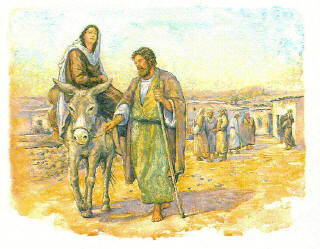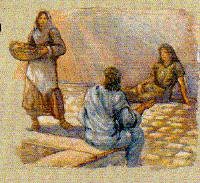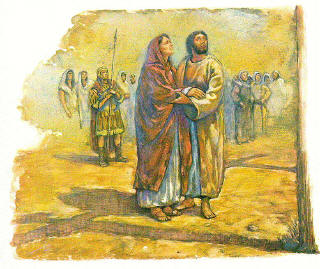Women in Church Leadership - a Series of Study Papers
The following study papers were commissioned by Grace Communion International as part of its consideration of whether women may be ordained.
6. Women in the Four Gospels
6.2. Women in the Ministry of Jesus
James Hurley writes, “The most striking thing about the role of women in the life and teaching of Jesus is the simple fact that they are there.[16] Although the gospel texts contain no special sayings repudiating the view of the day about women, their uniform testimony to the presence of women among the followers of Jesus and to his serious teaching of them constitutes a break with tradition which has been described as being ‘without precedent in [then] contemporary Judaism.'”[17]
As Schreiner says, “Jesus treated women with dignity and respect and he elevated them in a world where they were often mistreated.”[18]Hurley writes that Jesus did not perceive women “primarily in terms of their sex, age or marital status; he seems to have considered them in terms of their relation (or lack of one) to God.”[19] Borland’s summary is a good one:
Numerous healings and the casting out of demons from women display Jesus’ care and concern for women. Several such incidents are only briefly recorded. Jesus healed Peter’s mother-in-law and allowed her in return to minister to Him (Mark 1:30-31; Matthew 8:14-15; Luke 4:38-39). Jesus also was concerned for a widow in Nain (Luke 7:11-15). He met her as she was weeping just before burying her only son. With compassion, He spoke to her and raised her son to life.
Later, Christ healed a woman who was hopelessly bent over for eighteen years (Luke 13:10-17). Courageously, on the Sabbath and inside the synagogue before hostile religious leaders, Jesus helped and defended this poor woman. He spoke to her, tenderly placed His hands on her, and caused her to stand erect, for which she glorified God. He then acknowledged her equal standing with men in Israel’s religious heritage by referring to her as a daughter of Abraham (cf. John 8:33, 39).[20]
Sheila Graham writes,
Jesus’ honor and respect was…extended to all women—an attitude largely unexpected and unknown in his culture and time. Jesus, unlike the men of his generation and culture, taught that women were equal to men in the sight of God. Women could receive God’s forgiveness and grace. Women, as well as men, could be among Christ’s personal followers. Women could be full participants in the kingdom of God…. These were revolutionary ideas. Many of his contemporaries, including his disciples, were shocked.[21]
Elizabeth
We begin our brief survey of women in the ministry of Jesus with a woman whose role occurred before Jesus was born. Elizabeth, wife of the priest Zechariah, was noted to be “upright in the sight of God” and fully obedient (Luke 1:6).[22] When Mary visited Elizabeth, “the baby leaped in her womb, and Elizabeth was filled with the Holy Spirit” and pronounced a blessing on Mary—words that are now part of Scripture (vv. 41-45).
 Mary
Mary
The mother of Jesus set a marvelous example with her words, “I am the Lord’s servant…. May it be to me as you have said” (v. 38). Mary was also inspired to say a poem of praise that is now part of Scripture (vv. 46-55). She again set a good example when she “treasured up all these things and pondered them in her heart” (2:19, 51). She was instrumental in Jesus’ first public miracle (John 2:1-11). She may have been among the “family” who thought that Jesus had lost his sanity (Mark 3:21). At the cross, Jesus assigned John to take care of his mother, and Mary was counted among the disciples after his resurrection (Acts 1:14).
Borland writes, “The woman whom God chose to have the most extensive association with Jesus was His mother, Mary…. Mary’s life was significant for at least three reasons. (1) She was a first-hand witness of Jesus’ divine origin and true humanity. (2) She was a tremendous model of godliness, faith, dedication, and patience, among other good qualities. (3) She, along with other women, was incorporated into the new life of the church at Pentecost.”[23]
Anna
When Jesus was taken to the temple to be dedicated, an elderly prophetess named Anna “gave thanks to God and spoke about the child to all who were looking forward to the redemption of Jerusalem” (Luke 2:38). Unfortunately, we do not know what she said or how she spread the news.
 Mary and Martha
Mary and Martha
Although the rabbis said that men should not talk with women, Jesus counted women among his friends. “Jesus loved Martha and her sister and Lazarus” (John 11:5). Once when Jesus was visiting Bethany, “a woman named Martha opened her home to him” (Luke 10:38). Since Martha owned a home; she may have been a widow. Her sister Mary “sat at the Lord’s feet listening to what he said” (v. 39). But Martha was busy preparing the meal, and asked Jesus to tell Mary to help her.
The rabbis said that women should not be taught the Torah,[24] so Mary was shirking a typically female role in order to do something that was normally restricted to males. But Jesus did not “put her in her place.” Rather, he said that she had chosen the right place at the time. “Only one thing is needed. Mary has chosen what is better, and it will not be taken away from her” (v. 42). Spiritual growth is more important than domestic duties.[25]
Borland notes, “Jesus did not order [Martha] to stop serving but gently corrected her attitude about Mary.”[26] Graham writes, “Jesus did not feel that women’s work—or men’s work, for that matter—wasn’t important. He was not saying it is wrong to be diligent and careful about our responsibilities. Christ was saying we should get our priorities straight. Women were called to be disciples of Jesus, just as men were, and women were expected to fulfill their spiritual responsibilities, just as men were.”[27]
Borland further notes that Mary set a great example for all of us today:
Women are to learn and apply the Word of God. This is vitally important. But actually, the application is much broader…. Every believer must make countless decisions throughout life, constantly choosing to act as a pupil with Jesus as the teacher. It does not mean that other duties or Christian graces are to be ignored, but it does imply that some things…are more important than other things. There are no role distinctions for learning from Christ.[28]
In that incident, Mary set a better example than Martha did. But Borland notes that Martha should be remembered for another incident as well: “On a later visit of Jesus to Bethany, it was Martha who was taught by Jesus while Mary sat in the house (John 11:20)…. Martha gave a superb confession about Christ, saying, ‘Yes, Lord, I believe that You are the Christ, the Son of God, who is to come into the world’ (John 11:27, NKJ).”[29]
Samaritan woman at the well
“The conversation with the woman at the well is the longest recorded discussion Jesus had with anyone—and she, a Gentile woman.”[30]Further, the lesson Jesus gave her about living water was just as profound as the lesson he gave Nicodemus—and the woman had a better response. Unlike Nicodemus, she was willing to be associated with Jesus. She told her neighbors about Jesus, and many of them believed in Jesus “because of the woman’s testimony” (John 4:28-29, 39).
Davidson observes that this implies something positive about the reputation of the woman in the community: “It is unlikely that the men of a town would believe a prostitute’s word about the Messiah or anybody, and go openly with her to see him. Perhaps this woman has not been given due credit for her true social position in Samaria. The narrative seems to indicate that she was a knowledgeable, informed woman. Her discourse with Christ reveals an intelligent familiarity with the foremost theological issues of the day.”[31]
A daughter of Abraham
When Jesus was teaching in a synagogue, a woman who had been crippled for 18 years came in, and Jesus healed her (Luke 13:10-13). The synagogue ruler criticized Jesus, but Jesus defended himself, saying that the woman was “a daughter of Abraham” (v. 16).
Graham writes, “Before his most venomous critics, Jesus publicly showed his concern and high regard for this woman, someone whom others had probably seen for years as she struggled in her affliction to come to the synagogue to worship God. Someone whom they may well have shunned because she was a woman and because she was disabled.”[32] By using the rare phrase “daughter of Abraham,” Jesus was reminding the people that women were also among the descendants of Abraham and eligible for the blessings.
Joanna and Susanna
Luke tells us that several women who had been healed helped support Jesus “out of their own means” (Luke 8:3). These included “Joanna the wife of Cuza, the manager of Herod’s household; Susanna; and many others.”[33] Although they were probably involved in meal preparation, Luke indicates that their most significant role was to pay the bills.
Graham writes, “Some of these women—possibly widows—had control of their own finances. It was out of their generosity that Jesus and his disciples were at least partially supported. Although Christ worked with the cultural traditions of the first century, he ignored the limitations that had been placed on women by their culture. Women were free to follow him and to take part in his ministry to the world.”[34]
Belleville further observes, “They are the only supporters mentioned. Also, they did not merely write a check to cover the expenses but accompanied Jesus and the Twelve as they traveled from place to place…. Jesus welcomed women among his traveling coterie, allowing them to make the same radical commitment in following him that the Twelve did…. That married women would be traveling with Jesus’ group is striking indeed.”[35] “Jesus expected men and women to mix freely,” Mary Evans writes.[36] The solution to lust was not to segregate women, but for men to control themselves.
Matt. 27:55-56 also mentions that “many women…had followed Jesus from Galilee to care for his needs. Among them were Mary Magdalene, Mary the mother of James and Joses, and the mother of Zebedee’s sons” (Mark 15:41 reports that her name was Salome). Luke 23:27 reports that many women from Jerusalem followed him after his arrest, and he turned to them and taught them, saying that even worse times would come for Jerusalem.
A woman with bleeding
While Jesus was on his way to the home of Jairus, a woman who had been hemorrhaging for 12 years touched him, and was healed (Mark 5:22-29). She was afraid that Jesus would be angry (rabbis normally avoided women, especially unclean ones), but Jesus was not angry. He said, “Daughter, your faith has healed you” (v. 34)—addressing her with a term of affection and publicly praising her faith. Similarly, Jesus was not afraid of touching the other unclean daughter, the dead child of Jairus (v. 41).
Mary Magdalene
Luke tells us that Mary of Magdala had seven demons cast out of her (Luke 8:2), but Mary should be better known as the first to see the empty tomb, the first to carry the good news to the disciples. Graham writes:
Mary is almost always mentioned first in a list of the female disciples of Jesus Christ. She may have been one of the leaders of that group of women who followed Jesus from the outset of his ministry in Galilee to his death and afterward. The risen Jesus appeared to her first. It’s ironic that in a time when women could not be legal witnesses, Jesus Christ chose women as the first witnesses of his resurrection.[37]
 Although the men fled for their lives, the women faithfully followed Jesus to the cross (Matt. 27:55-56), and Mary sat nearby while Joseph of Arimathea put Jesus’ body in the tomb (v. 61). Mary led the women who came to anoint Jesus early on Sunday morning (Mark 16:2), and an angel told them that Jesus had been raised (v. 6). They then told the news to the 11 disciples (Luke 24:10). Jesus appeared first to Mary (John 20:14), and told her to tell the disciples, which she did (vv. 17-18).
Although the men fled for their lives, the women faithfully followed Jesus to the cross (Matt. 27:55-56), and Mary sat nearby while Joseph of Arimathea put Jesus’ body in the tomb (v. 61). Mary led the women who came to anoint Jesus early on Sunday morning (Mark 16:2), and an angel told them that Jesus had been raised (v. 6). They then told the news to the 11 disciples (Luke 24:10). Jesus appeared first to Mary (John 20:14), and told her to tell the disciples, which she did (vv. 17-18).
Schreiner writes, “Even though the testimony of women was not received by courts…Jesus appeared to women first, showing again their significance and value as human beings.[38] Borland, another conservative, comments on the significance:
Why were the women chosen as witnesses of the resurrection? Was God bestowing a special honor on these women? Was God trying to indicate larger roles for women in His new community of believers? I believe both were intended. All four Gospel writers bestow a great honor on the women who lovingly and with servant hearts came early to the tomb to anoint Jesus’ body, thus paying their last respects…. These women led the way in proclaiming the gospel…. The duty and high privilege of witnessing for Christ is still open to every believer, without distinction as to gender.[39]
Some scholars have noted that the women were told to bear witness to the fact that Jesus had risen—and this is one of the criteria for an apostle (Acts 1:22). But there is no evidence that any of these women ever functioned as witnesses of the resurrection in the public preaching of the church. Although their role in the resurrection was an important precedent for women speaking with authority, it was a restricted role for a specific need within the church.
[16] Borland agrees: “Jesus regularly addressed women directly while in public. This was unusual for a man to do” (114).
[17] James Hurley, 82-83, citing W. Forster, Palestinian Judaism in New Testament Times (London, 1964), 124. Some example of Jewish views of women:
- “Any iniquity is small compared to a woman’s iniquity…. From a woman sin had its beginning, and because of her we all die” (Sirach 25:19, 24; 2nd century B.C.).
- “Better is the wickedness of a man than a woman who does good; it is woman who brings shame and disgrace” (Sirach 42:14).
- “The woman is inferior to the man in every way” (Josephus, Against Apion 2:201).
- “A hundred women are no better than two men” (Talmud, Ber. 45b) Although the Talmud was written well after the New Testament, in this case it is probably in agreement with first-century attitudes.
- “A man is required to say the following three blessings every day: ‘Blessed are you who have not made me a heathen, who have not made me a woman, who has not made me illiterate” (bMen. 43b; Ber. 7.18).
- “There is no wisdom in woman except with the spindle” (bYom. 66b).
[18] Schreiner, 184.
[19] Hurley, 83.
[20] Borland, 115.
[21] Sheila Graham, “Jesus and Women,” The Plain Truth (July 1994): 15, available on our website at https://www.gci.org/jesus/women
[22] Luke may have stressed this because some people might assume that sin had caused Elizabeth to be barren. She refers to the “disgrace” of being barren in v. 25.
[23] Borland, 118-119.
[24] “It is better that the words of the Law should be burned than that they should be given to a woman” (jSot. 3.4; 19a).
“If a man gives his daughter a knowledge of the Law, it is as though he taught her lechery” (bSot. 4.3).
[25] This does not mean that domestic duties should never be done. Jesus himself washed feet and cooked fish. Jesus never assigned (nor does the Bible assign) domestic duties to women only.
[26] Borland, 119.
[27] Graham, 16-17.
[28] Borland, 118.
[29] Borland, 118.
[30] Davidson, 173.
[31] Davidson, 173. Scholars often assume that the woman was immoral. She had five previous husbands, yes, but they may have died or divorced her due to no fault of her own. She was not married to the man she was living with, but the law of Moses did not regulate the sexual behavior of unmarried nonvirgins.
[32] Graham, 18.
[33] Mary Magdalene is also mentioned, but we will discuss her separately.
[34] Graham, 18.
[35] Belleville, 51.
[36] Mary J. Evans, Woman in the Bible (InterVarsity, 1983), 47.
[37] Graham, 15. Josephus wrote, “From women let no evidence be accepted because of the levity and temerity of their sex” (Antiquities 4:219).
[38] Schreiner, 185-86. However, Evans writes, “It would be a mistake to over-emphasize the point, as it is quite possible that the women received the message first simply because they happen to have been there first” (p. 54).
[39] Borland, 120.